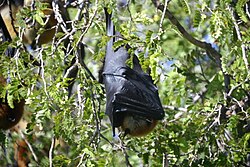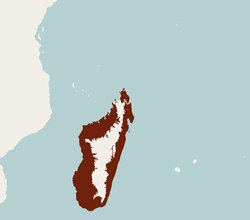| Madagascan flying fox | |
|---|---|
 | |
| Scientific classification | |
| Kingdom: | Animalia |
| Phylum: | Chordata |
| Class: | Mammalia |
| Order: | Chiroptera |
| Family: | Pteropodidae |
| Genus: | Pteropus |
| Species: | P. rufus |
| Binomial name | |
| Pteropus rufus É. Geoffroy, 1803 | |
 | |
| Madagascan flying fox range | |
The Madagascan flying fox, Madagascar flying-fox, or Madagascar fruit bat (Pteropus rufus) is a species of megabat in the genus Pteropus . It is endemic to Madagascar. Its natural habitats are diverse, and include moist lowland forests, dry forests, succulent woodlands, and spiny thickets, and mangroves. It eats figs and other fruits, flowers, and leaves. It is threatened by habitat loss. [1]
